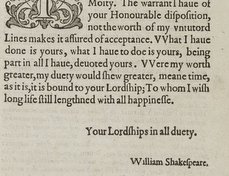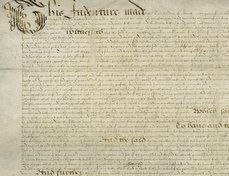Images reproduced by permission of The National Archives, London, England.
Terms of use
The National Archives give no warranty as to the accuracy, completeness or fitness for the purpose of the information provided.
Images may be used only for purposes of research, private study or education. Applications for any other use should be made to The National Archives Image Library, Kew, Richmond, Surrey TW9 4DU, Tel: 020 8392 5225 Fax: 020 8392 5266.
Document-specific information
Creator: Court of Requests
Date: ca. 1620
Repository: The National Archives, Kew, UK
Call number and opening: REQ 1/200
View online bibliographic record
In 1606 John Witter of Mortlake, Surrey, married Anne Phillips, widow of Augustine Phillips, a member of the King’s Men who had died in 1605. Though Anne was both a beneficiary and the executrix of her deceased husband’s estate, a clause in Phillips’s will stipulated that, should she re-marry, the executorship of the estate, including the Phillips share in the Globe, would pass to his overseers John Heminges, Richard Burbage, and William Slye, who were principal actors with the King’s Men, and to Timothy Whitehorn. Accordingly, in 1607, a year after Anne’s remarriage, the executorship passed to John Heminges (Playhouse Wills, p. 74). Following Anne’s death in January 1618, Witter sued Heminges and Henry Condell for her share in the Globe. The resulting lawsuit, from which eight documents survive, provides useful information on the Globe site and the Globe playhouse. One document, the Answer of Heminges and Condell specifically names William Shakespeare.
This entry from the contemporary Witness Book from 1620 indicates that Thomas Woodford, gent, and James Knasborough, gent, were called to depose in this case, which was opened on April 20, 1619 with Witter’s Complaint. Though the Final Decree (1619-20) confirms that “certen witnesses” were examined, no depositions have been found.
Of the two named witnesses, Woodford may be identified as a citizen of London and “Salter” who survived until 1639 (TNA PROB 11/181/380). Knasborough, then a resident of nearby Richmond, was buried in the church of St. Dunstan in the West, London, June 16, 1629 (Ancestry.com). Two years before the start of Witter’s suit, under 1615-16, the Middlesex Sessions Records report that John Witter of Surrey was charged “for wounding James Knavesberry of Mortlake aforesaid, gentleman” (Ancestry.com). Given this charge, Knasborough/Knavesberry must surely have served as a witness for the defendants Heminges and Condell.
[This transcription is pending final vetting. Transcription based on Charles William Wallace, "Shakespeare and his London Associates, As Revealed in Recently Discovered Documents" University of Nebraska Studies, vol. 10 no. 4 (1910), 74.]
[List of witnesses examined ex parte Witter Hilary Term, xvijo James I (1620).]
...
Iohn Witter gent plaintiff Thomas Woodford gent
James Knasborough gent
Iohn Heminges and
Henry Condall gent
defendantes
...
[Wallace: “The depositons of Thomas Woodford and James Knasborough, taken February, 1620, are wanting.”]
Note: Wallace assumes that the two witnesses appeared on behalf of the plaintiff; but given that Witter wounded James Knasborough in an encounter dated 1615-16 (see Essay), this assumption may be questioned.
To learn more, read Alan H. Nelson's essays on lawsuits in Shakespeare's England, and the 1599 lease of the Globe playhouse site.
Written by Alan H. Nelson
Sources
Charles William Wallace, "Shakespeare and his London Associates, As Revealed in Recently Discovered Documents" University of Nebraska Studies, vol. 10 no. 4 (1910), 74.
Last updated May 14, 2018










